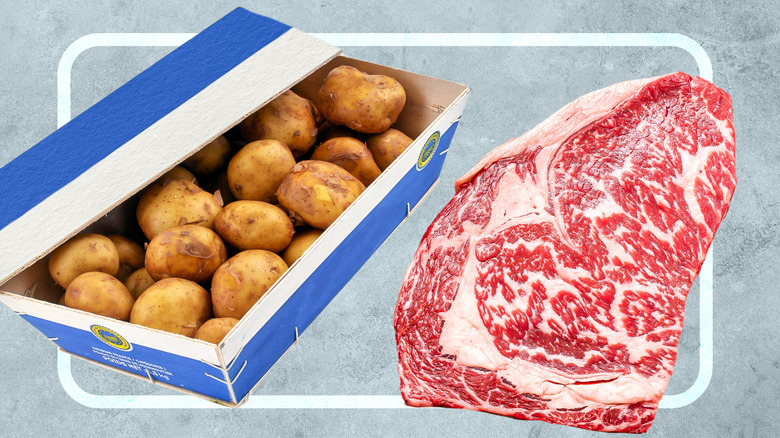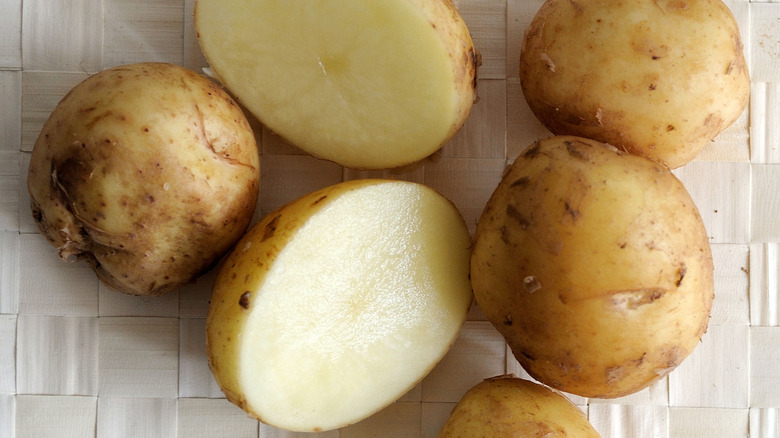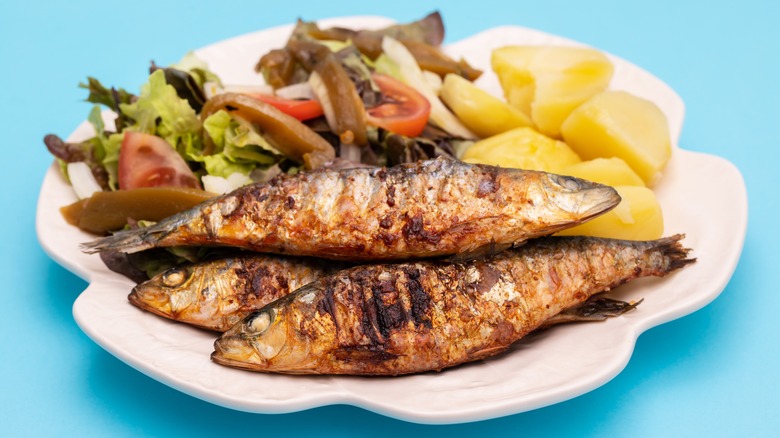This Rare Potato Variety Is More Expensive Than Wagyu Beef
On any list of expensive luxury foods, you'll probably find the usual suspects like truffles, wagyu or Kobe beef, and caviar — but there's also a type of potato that's just as pricey (if not more so) than these ritzy delicacies. That potato is called the Bonnotte de Noirmoutier, but it's often referred to as simply "La Bonnotte." It's only grown on the island of Noirmoutier off the west coast of France (hence the name). If you're feeling like some absurdly expensive sides for your roast dinner, look no further: Bonnottes sell for around $215 to $270 USD per pound (compared to about $200 for a pound for wagyu beef).
These potatoes are notable for their distinctive taste. They have a bright flavor with lemony notes and a mineral, sea-salt aftertaste, as if they came pre-seasoned. There's a nutty component, too: Some say they have a walnut taste, others say chestnut. The potato's interior is particularly smooth, and when cooked, chefs consider these spuds exceptionally tender. They're more of a waxy potato than a starchy one.
If you don't want to pay top dollar for Bonnottes, British supermarket Tesco has sold a cheaper version; however, these are grown on the island of Jersey, which has a similar climate, but since they're not from Noirmoutier, some don't consider them the same potato. Alternatively, you can get a bargain if you travel to Noirmoutier to either harvest some yourself or to buy them directly from the source.
Why are Bonnottes so expensive?
Bonnottes grow in Noirmoutier's sandy soil, which is part of the reason they're considered special — this soil gives the potatoes an oceanic taste, which is aided by the fact that they're fertilized with seaweed. Generally speaking, the potatoes are a hit because of their unique flavor, and while this contributes to their high price, it's not the only reason for it.
These potatoes — especially their skins — are delicate compared to other spuds, and they can only be picked by hand, which substantially increases labor costs. This is unlike most other potatoes, which are harvested in far larger volumes with machinery that speeds up the process. Back in the 1960s, interest in the Bonnotte dropped off because their harvesting was so finicky, but starting in the 1990s, farmers on Noirmoutier started growing them again and found a market. On top of that, these potatoes are only grown on a small portion of the island, limiting the number of potatoes that can hit shelves — and each plant yields just 7 ounces of potatoes on average.
On top of all that, Bonnottes are only harvested for around one week to 10 days each year, usually in mid-May. This means there's a limited window in which they can be sold, from the harvest into early June. Combine all these factors, and voilà: You have one rare, expensive potato.
[Featured image by BastienM via Wikimedia Commons | Cropped and scaled | CC BY-SA 3.0]
How are Bonnottes eaten?
If you paid $100-plus for a potato, you would likely — and understandably — have a hard time deciding what to do with it. On one hand, it might seem silly to turn something so expensive into fries or mash, but on the other, you can't just bite into a raw potato like it's an apple, specifically because of the presence of lectins, a protein that can cause digestive troubles.
The number-one rule for cooking with Bonnottes is that you shouldn't peel them: The skin is packed with flavor and is the part that absorbs that salty seawater (and seaweed) taste. If you want to take the traditional route, residents of Noirmoutier eat the potatoes steamed or fried along with grilled sardines. These potatoes can work in all sorts of dishes, from soups even to desserts, where their smooth texture makes them great for a dough that can, for example, be turned into a classic French cake (here are 20 that you need to try at least once). Common wisdom, however, is to keep it simple and let the potatoes shine without too many extra ingredients.
Consider boiling, steaming, roasting, or frying them — perhaps with a little olive oil and butter, maybe some herbs, and some fleur de sel to finish them off. They pair well with seafood or shellfish and with salt-crusted meats.


